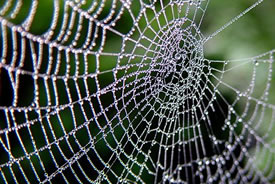Seeing the connections: A systems approach to conservation

Spiderweb (Photo by Josef F Stuefer, Wikimedia Commons)
In order to protect something, you must understand it first. For anyone who wants to protect nature, it is important to understand all the components that make up the environment, and see the connections between them. This is where systems thinking comes in. Basically, a system is anything that is made up of interrelated parts, and systems thinking emphasizes the importance of understanding what roles the different parts play, and more importantly, the relationships between them. It is a helpful tool for making sense of the complex interactions found in nature.
I find that the easiest way for me to explain the environment is to use the human body as a metaphor. The various systems of the body (the digestive system, circulatory system, nervous system and so on) are similar to the components of the environment (the water cycle, carbon cycle, soils, species, etc.). The components themselves are independent and complex, but they are all connected to form the whole. Just as a doctor needs to understand the functions and connections of the organ systems, an environmental scientist must understand how the components of the environment interact with each other. Because they are so intricately connected, the health of the whole system depends on the health of all of its parts.
Because this concept is so important in environmental science, it’s no wonder that many of my environmental courses in university touched on systems thinking. Many of our professors also encouraged us to think about connections beyond the ones found in nature, and to think about the role that we as individuals play in our jobs, families and communities. Once you start looking for connections, as cheesy as it sounds, you quickly realize that everything really is connected.
This is also the reason why I jumped at the opportunity to work as receptionist at the Nature Conservancy of Canada’s (NCC's) office in Toronto. When I first started reading about NCC’s work, I realized that the organization’s approach fits right in with the systems-based environmental science I had learned in school. NCC’s goal is to acquire and protect natural areas, while working at different ecological scales. By protecting entire properties and trying to acquire large tracts of ecologically significant land, NCC is able to protect all the species and connections within them. By working at different scales of conservation, NCC is able to better identify the threats and ecological importance of natural areas.
When I started working, I quickly learned about all the different Regions and departments, such as finance, communications and marketing, that are needed to maintain NCC’s conservation work in the field. While the departments often work independently, they are all working together towards a common goal. Even with all these internal components, NCC could not accomplish the work it does by itself. Our work would not be able to continue without the help of our donors and supporters.
No matter how small our influence may seem, we all play an important role in the conservation work that the Nature Conservancy of Canada does, and in all the other “systems” we are part of.


